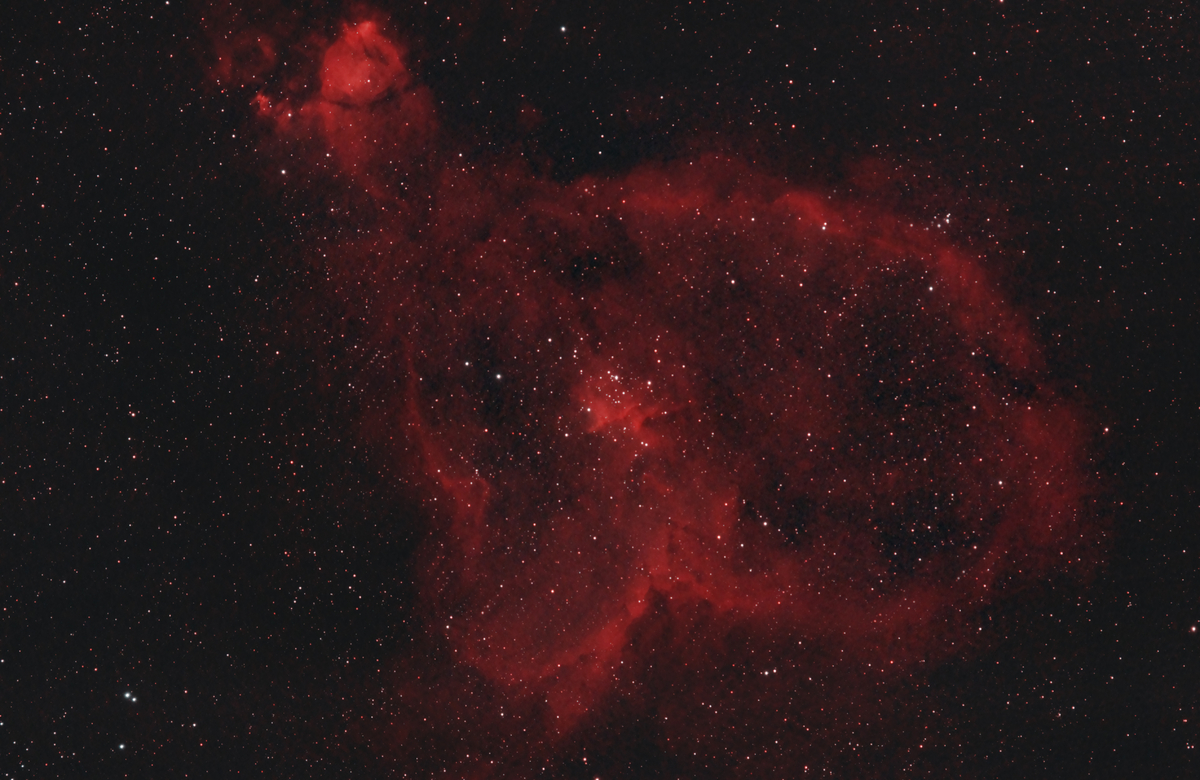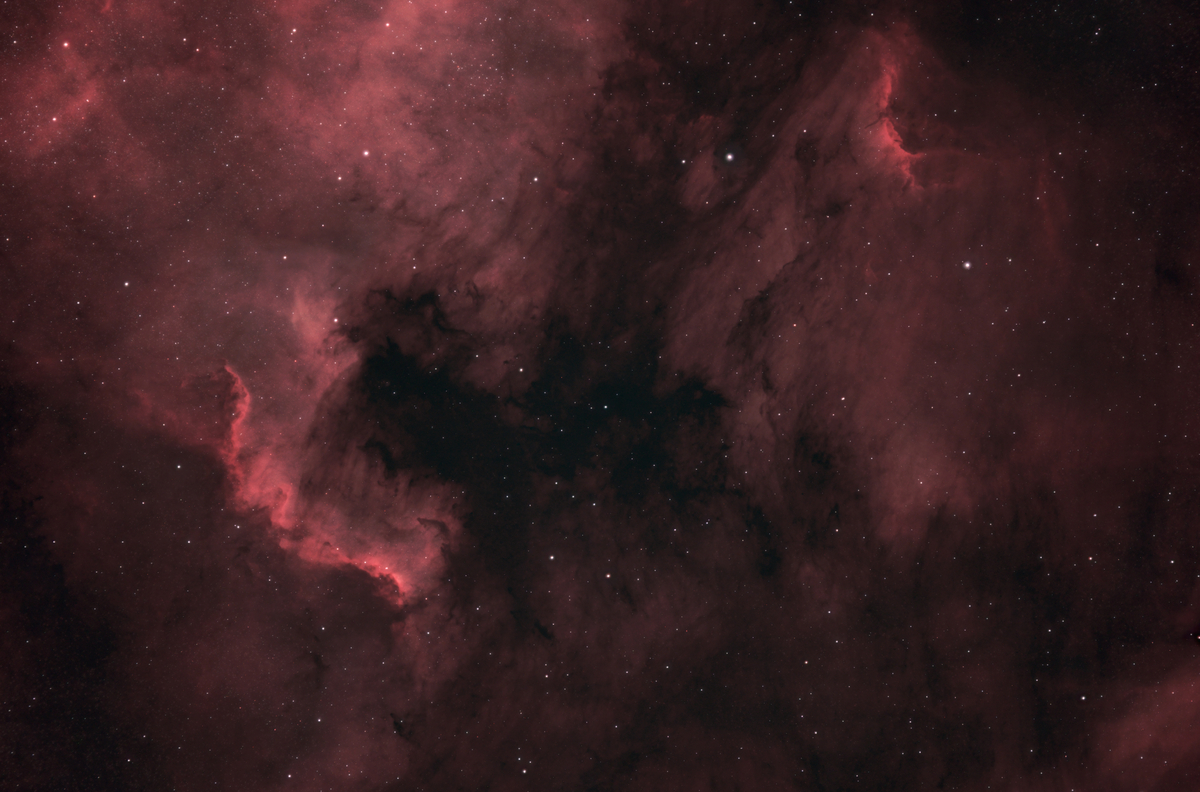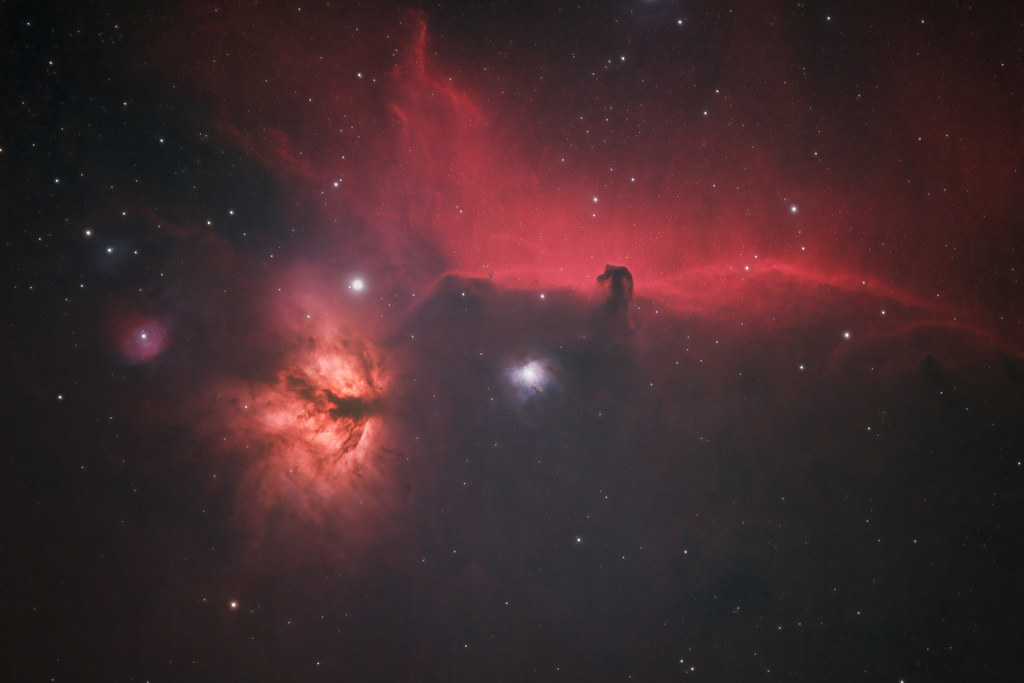You are using an out of date browser. It may not display this or other websites correctly.
You should upgrade or use an alternative browser.
You should upgrade or use an alternative browser.
smr's Astrophotography
- Thread starter smr
- Start date
More options
View all postsThe Heart Nebula
This is 6 hours total integration, consisting of 5 minute single exposures.
Telescope: William Optics Zenithstar 73
Mount: Sky-Watcher HEQ5 Pro Rowan Belt Mod
Autoguiding Scope: Starwave 50mm Guidescope
Autoguiding Camera: ZWO ASI 120MM Mini
Camera: Canon 600D Astromodified
Optolong L-eNhance Dual Narrowband Filter
The Heart Nebula is in the constellation Cassiopeia, and is 6000 Light Years from Earth. Clouds of ionised hydrogen make up the Nebula.

Also a video featuring this image on my channel where I plate solve to find targets:
This is 6 hours total integration, consisting of 5 minute single exposures.
Telescope: William Optics Zenithstar 73
Mount: Sky-Watcher HEQ5 Pro Rowan Belt Mod
Autoguiding Scope: Starwave 50mm Guidescope
Autoguiding Camera: ZWO ASI 120MM Mini
Camera: Canon 600D Astromodified
Optolong L-eNhance Dual Narrowband Filter
The Heart Nebula is in the constellation Cassiopeia, and is 6000 Light Years from Earth. Clouds of ionised hydrogen make up the Nebula.

Also a video featuring this image on my channel where I plate solve to find targets:
Awesome. Just subscribed to your YT channel as well.
Ah thanks very much.
Amazing photo, smr. I love these images, they really make you think.
That distance is crazy. 6000 x 6 trillion miles. I watched a video tutorial last night (not that I'm about to get into attempting astro, just found the process interesting but complicated) where someone had captured with just a 60D, a tripod and something called a bodenav mask that he'd 3D printed, the andromeda galaxy and that's 2 and a half million light years away! That's zillions of trillions of miles way. Hard to get your head around these distances. Even 1 light year would take 37,000 years to travel in a space shuttle. I wonder what distance the heart nebula is from one side to the other, I bet it's a few light years across.
Thanks! Yep the distances are surreal, I think it'd take a pretty long time for a 737 to fly from one end of the Heart Nebula to the other!
I've been looking forward to imaging this Nebula for the first time after imaging the Eastern Veil Nebula around this time last year.
Taken with my astro modified 600D DSLR and HEQ5 Pro
6h41m Lights
Bias
ISO 800
L-eNhance Filter
Bortle 5/6
The Witches Broom Nebula
Between 10 and 20,000 years ago a Star in a Supernova 20 times more massive than our Sun exploded. The Witches Broom is a remnant of that Supernova explosion. Oxygen, Sulphur and Hydrogen make up the emissions of the Nebula, at a distance of 2,400 Light Years.
 The Witches Broom Nebula by Joel Spencer, on Flickr
The Witches Broom Nebula by Joel Spencer, on Flickr
Taken with my astro modified 600D DSLR and HEQ5 Pro
6h41m Lights
Bias
ISO 800
L-eNhance Filter
Bortle 5/6
The Witches Broom Nebula
Between 10 and 20,000 years ago a Star in a Supernova 20 times more massive than our Sun exploded. The Witches Broom is a remnant of that Supernova explosion. Oxygen, Sulphur and Hydrogen make up the emissions of the Nebula, at a distance of 2,400 Light Years.
 The Witches Broom Nebula by Joel Spencer, on Flickr
The Witches Broom Nebula by Joel Spencer, on Flickr
Last edited:
incredible stuff here! well done sir
Thanks very much!
Well done superb images ... brings back memories
I used to be into astrophotograpy but since getting married and family life getting in way sold most of my setup through lack of time.
I think I'm not going to be able to get into it till I retire in 30 years time.
Thanks very much! Yes it can be difficult balancing photography with family life. With how technology is progressing it's quite easy to get good images more quickly these days though.
The first Astrophotography Image at my new House, the California Nebula.
The Nebula is located in the Constellation Perseus. It's named after the outline of the Nebula resembling the US State of California.
A distance of 1,000 Light Years from Earth.
Canon 600D Modded
William Optics ZenithStar 73 Refractor
HEQ5 Pro Rowan Belt Modded
Optolong L-eNhance Filter
3 hour 30 minutes of 5 minute Subs
ISO 800
Dithered and Bias
 California Nebula by Joel Spencer, on Flickr
California Nebula by Joel Spencer, on Flickr
The Nebula is located in the Constellation Perseus. It's named after the outline of the Nebula resembling the US State of California.
A distance of 1,000 Light Years from Earth.
Canon 600D Modded
William Optics ZenithStar 73 Refractor
HEQ5 Pro Rowan Belt Modded
Optolong L-eNhance Filter
3 hour 30 minutes of 5 minute Subs
ISO 800
Dithered and Bias
 California Nebula by Joel Spencer, on Flickr
California Nebula by Joel Spencer, on Flickr
Last edited:
Hi guys,
Here's my latest image, the Rosette Nebula...
The Rosette Nebula (also known as Caldwell 49) is an H II region located near one end of a giant molecular cloud in the Monoceros region of the Milky Way Galaxy. The open cluster, NGC 2244, (Caldwell 50) is closely associated with the nebulosity, the stars of the cluster having been formed from the nebula's matter.
The cluster and nebula lie at a distance of 5,000 light years from Earth and measure roughly 130 light years in diameter. The radiation from the young stars excites the atoms in the nebula, causing them to emit radiation themselves producing the emission nebula we see. The mass of the nebula is estimated to be around 10,000 solar masses.
Imaged over two nights.
Canon 600D, Optolong l-eNhance Filter
5 hours 26 minutes, 233 Subs, 20 Flats, 200 Bias
 Rosette by Joel Spencer, on Flickr
Rosette by Joel Spencer, on Flickr
Here's my latest image, the Rosette Nebula...
The Rosette Nebula (also known as Caldwell 49) is an H II region located near one end of a giant molecular cloud in the Monoceros region of the Milky Way Galaxy. The open cluster, NGC 2244, (Caldwell 50) is closely associated with the nebulosity, the stars of the cluster having been formed from the nebula's matter.
The cluster and nebula lie at a distance of 5,000 light years from Earth and measure roughly 130 light years in diameter. The radiation from the young stars excites the atoms in the nebula, causing them to emit radiation themselves producing the emission nebula we see. The mass of the nebula is estimated to be around 10,000 solar masses.
Imaged over two nights.
Canon 600D, Optolong l-eNhance Filter
5 hours 26 minutes, 233 Subs, 20 Flats, 200 Bias
 Rosette by Joel Spencer, on Flickr
Rosette by Joel Spencer, on Flickr
Last edited:
Hi guys,
So I now have my 2600MC Pro - my first dedicated Astronomy Camera.
Here's first light, the Soul Nebula is 6,000 Light Years away from Earth.
7 Hours of integration time spanning two full Moon nights.
180 Second Subs, Gain 100, Offset 50, L-eNhance Filter
Cooled to -10, 30 Darks, 20 Flats (each session, 20 Dark Flats)
HEQ5 Pro (Rowan Belt Mod)
William Optics Zenithstar 73
Altair 50mm Starwave Guidescope
PHD2
APT
Stacked in DSS and Processed in Adobe Photoshop
 Soul Nebula by Joel Spencer, on Flickr
Soul Nebula by Joel Spencer, on Flickr
So I now have my 2600MC Pro - my first dedicated Astronomy Camera.
Here's first light, the Soul Nebula is 6,000 Light Years away from Earth.
7 Hours of integration time spanning two full Moon nights.
180 Second Subs, Gain 100, Offset 50, L-eNhance Filter
Cooled to -10, 30 Darks, 20 Flats (each session, 20 Dark Flats)
HEQ5 Pro (Rowan Belt Mod)
William Optics Zenithstar 73
Altair 50mm Starwave Guidescope
PHD2
APT
Stacked in DSS and Processed in Adobe Photoshop
 Soul Nebula by Joel Spencer, on Flickr
Soul Nebula by Joel Spencer, on Flickr
Last edited:
That's not cheap!
It certainly isn't!
Nice. Loads of detail.
Thanks. Really pleased with the image, especially considering the Moon was full on both nights. Looking forward to imaging without the Moon lighting the sky up!
The Eastern Veil Nebula
The Veil Nebula is a cloud of heated and ionized gas and dust in the constellation Cygnus, a supernova remnant and part of the Cygnus Loop. The source supernova was a star 20 times more massive than our Sun, which exploded between 10,000 and 20,000 years ago. NGC 6992 is around 2,400 light-years from Earth and is expanding at a velocity of about 1.5 million kilometers per hour.
Acquisition
HEQ5 Pro Rowan Belt Modded German Equatorial Mount
William Optics Zenithstar 73 Refractor - 420mm f/5.9
ZWO ASI 2600MC Pro Cooled Camera - Minus 10 Degrees Celcius
ZWO 120MM Mini Guide Camera
Altair Starwave 50mm Guidescope
ZWO EAF Focuser
Stellarium
Plate Solving
PHD2 Guiding Software with multi-star guiding and Astrophotography Tool
Data
5 Hours and 25 Minutes x 180 second Exposures
Gain 100 - Offset 50
Calibrated with Dark Frames
Bortle 5/6
Processing
Stacked in Deep Sky Stacker
Processed in Adobe Photoshop
Levels Adjustment and initial Linear Stretching
Gradient Xterminator to balance background colour
Star Xterminator to separate Stars and Nebulosity
Star Layer Mask Colour Range 'Highlights' to increase star saturation
Background noise reduction on Nebulosity layer
Non-linear Curves adjustments on Nebulosity layer
Nebulosity layer masking; exposure, contrast and detail enhancement
 NGC 6992 - Eastern Veil Nebula by Joel Spencer, on Flickr
NGC 6992 - Eastern Veil Nebula by Joel Spencer, on Flickr
The Veil Nebula is a cloud of heated and ionized gas and dust in the constellation Cygnus, a supernova remnant and part of the Cygnus Loop. The source supernova was a star 20 times more massive than our Sun, which exploded between 10,000 and 20,000 years ago. NGC 6992 is around 2,400 light-years from Earth and is expanding at a velocity of about 1.5 million kilometers per hour.
Acquisition
HEQ5 Pro Rowan Belt Modded German Equatorial Mount
William Optics Zenithstar 73 Refractor - 420mm f/5.9
ZWO ASI 2600MC Pro Cooled Camera - Minus 10 Degrees Celcius
ZWO 120MM Mini Guide Camera
Altair Starwave 50mm Guidescope
ZWO EAF Focuser
Stellarium
Plate Solving
PHD2 Guiding Software with multi-star guiding and Astrophotography Tool
Data
5 Hours and 25 Minutes x 180 second Exposures
Gain 100 - Offset 50
Calibrated with Dark Frames
Bortle 5/6
Processing
Stacked in Deep Sky Stacker
Processed in Adobe Photoshop
Levels Adjustment and initial Linear Stretching
Gradient Xterminator to balance background colour
Star Xterminator to separate Stars and Nebulosity
Star Layer Mask Colour Range 'Highlights' to increase star saturation
Background noise reduction on Nebulosity layer
Non-linear Curves adjustments on Nebulosity layer
Nebulosity layer masking; exposure, contrast and detail enhancement
 NGC 6992 - Eastern Veil Nebula by Joel Spencer, on Flickr
NGC 6992 - Eastern Veil Nebula by Joel Spencer, on Flickr
Last edited:
That’s insanely good. And also a bit freaky as I was searching for this thread along with another a few days ago but couldn’t find this one for some reason.
Thanks very much. I had to search for the thread
 I haven't managed many Astro images this year thus far, clouds!
I haven't managed many Astro images this year thus far, clouds!Amazing stuff, @smr
Thanks very much !
Impressive! Thanks for sharing.
Thank you
Very good result for a single-shot colour cam, amazing how technology has advanced.
Also amazing how BIG the Veil neb is, I captured (almost) all of it with a large format CCD some years ago.
Best to click on the image and view on Flickr where you can zoom in - there's a lot of pixels
Yes it certainly is, I'll have a go at getting the whole lot one day, might have to do a mosaic unless I get a really widefield lens or refractor.
Hi, here's my latest Astro Photograph.
Imaged over three nights, this is my North American & Pelican Nebula image. The total exposure time is 8 hours and 12 minutes, consisting of 164 Lights. Calibrated with Darks (-10), Flats (from one night, along with dark flats). I omitted taking any after the first night, I did take flats after the second and third night's but I hadn't realised that I had ran out of disk space just as APT was taking flats on the morning after the third night - so I calibrated with just one set of flats from the second session, which seem to have worked alright.
Gear Acquisition
William Optics Zenithstar 73
ZWO 2600MC Pro
HEQ5 Pro Rowan Belt Mod
PHD2 (Multi-star guiding)
APT
Stacked in Deep Sky Stacker and processed in Adobe Photoshop.
Thanks for looking.
Joel

Imaged over three nights, this is my North American & Pelican Nebula image. The total exposure time is 8 hours and 12 minutes, consisting of 164 Lights. Calibrated with Darks (-10), Flats (from one night, along with dark flats). I omitted taking any after the first night, I did take flats after the second and third night's but I hadn't realised that I had ran out of disk space just as APT was taking flats on the morning after the third night - so I calibrated with just one set of flats from the second session, which seem to have worked alright.
Gear Acquisition
William Optics Zenithstar 73
ZWO 2600MC Pro
HEQ5 Pro Rowan Belt Mod
PHD2 (Multi-star guiding)
APT
Stacked in Deep Sky Stacker and processed in Adobe Photoshop.
Thanks for looking.
Joel

Delighted to unveil my image of the of Veil Nebula in the constellation Cygnus. I've finally finished processing it after photographing this on Holiday in Norfolk last month. The total exposure time is 3 hours and 20 minutes. This is one of my favourite objects in Deep Space, it's a supernova remnant from a Star which was 20 times more massive than our Sun, and exploded between 10,000 and 20,000 years ago. This part of the remnant is called the Witches' Broom, and below it, Pickering's Triangle. The emissions are made up of Hydrogen, Sulfur and Oxygen and it's 2,400 Light Years from Earth.
Acquisition > Skywatcher HEQ5 Pro Rowan Belt Mod - ZWO ASI 2600MC Pro - L-eNhance Dual Narrowband Filter - Altair Starwave 50mm Guidescope - PHD2 Guiding - DSS Stacking - PS Processing - 3h20m x 180 second subs, 50 Darks, 20 Flats, 20 Dark Flats.

Acquisition > Skywatcher HEQ5 Pro Rowan Belt Mod - ZWO ASI 2600MC Pro - L-eNhance Dual Narrowband Filter - Altair Starwave 50mm Guidescope - PHD2 Guiding - DSS Stacking - PS Processing - 3h20m x 180 second subs, 50 Darks, 20 Flats, 20 Dark Flats.



 Messier 42 - The Great Orion Nebula
Messier 42 - The Great Orion Nebula